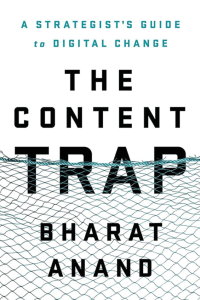In the digital realm, where content proliferates and platforms abound, solopreneurs must navigate through the labyrinth of endless options without losing sight of their core purpose. "The Content Trap: A Strategist’s Guide to Digital Change" by Bharat Anand is not just a book; it's a paradigm shift. It's an invitation to view content not as a standalone element but as a vital component within a vast, interconnected ecosystem.

"The Content Trap" serves as a clarion call for businesses to reframe their perspective on digital strategy. Anand, a professor at Harvard Business School, argues that an obsession with content — while often well-intentioned — can lead businesses into the titular "trap," focusing too narrowly on the content itself rather than on the connections it facilitates. The book pivots on several transformative insights:
- Connections Over Content: The emphasis on creating and leveraging connections instead of solely focusing on producing content.
- User Behavior and Network Effects: Understanding how users interact with content and with one another, and recognizing the exponential value of network effects.
- Strategic Thinking in Digital Transitions: Navigating the shift from traditional to digital spaces, with strategic considerations for content integration, platform selection, and audience engagement.
- Learning from Success and Failure: Analyzing case studies from various companies, discerning patterns in the strategies that work and those that don't.
For solopreneurs, "The Content Trap" is particularly enlightening because it challenges the conventional wisdom that "content is king." Instead, it posits that the real value lies in creating a network where content can thrive. It's about fostering connections, understanding the behavior of your audience, and creating an environment where content is not just consumed but shared, discussed, and integrated.
However, it's important to note that while "The Content Trap" offers profound strategic insights, it's not a how-to guide for content creation. The book doesn't delve into the practicalities of writing blog posts, scripting videos, or crafting social media updates. Instead, it focuses on a high-level strategic understanding of content's role and potential in the digital landscape.
In conclusion, "The Content Trap: A Strategist’s Guide to Digital Change" is a must-read for solopreneurs aspiring to carve a distinctive space in the digital world. It's not just about producing content; it's about recognizing content's place in the broader digital ecosystem. Anand's book encourages you to think beyond the content, to the connections it can forge, the conversations it can spark, and the communities it can build. In the digital space, where content is abundant, "The Content Trap" teaches you to focus on what truly matters: the connections that give content its life and power.
ChatGPT Prompts:
"The Content Trap: A Strategist’s Guide to Digital Change" by Bharat Anand delves into the importance of connectivity and networks over just content quality in the digital age. Here are some specific prompts for exploring this book more deeply:
Understanding the Concepts:
- "What is the 'Content Trap' as defined by Bharat Anand, and how do businesses fall into it?"
- "How does 'The Content Trap' emphasize the role of networks and connections in digital success?"
Application of Principles:
- "How can an online business use the principles from 'The Content Trap' to grow its user base and strengthen its network?"
- "Anand discusses the importance of user connectivity over content. How can companies foster this connectivity among users?"
Comparison with Other Strategies:
- "How do the strategies in 'The Content Trap' contrast with the common notion of 'content is king' in digital marketing?"
- "Can you compare the emphasis on connectivity in 'The Content Trap' with the focus on individual content quality in other marketing strategies?"
Exploring Specific Concepts:
- "What examples does 'The Content Trap' provide of successful businesses leveraging user networks and connections?"
- "How does 'The Content Trap' address the concept of 'viral content,' and what are the perceived misconceptions?"
Critiques and Limitations:
- "What are some potential criticisms or limitations of the strategies and viewpoints presented in 'The Content Trap'?"
- "Are there certain types of businesses or sectors for which the principles of 'The Content Trap' might be less applicable?"
Expansion Ideas:
- "How can the network-focused principles of 'The Content Trap' be applied to sectors like education or non-profit?"
- "Can the concepts in 'The Content Trap' be applied to community building or social movements?"
Real-world Examples:
- "Can you identify a company that successfully avoided the 'Content Trap' by focusing on user connectivity and networks?"
- "What's an example of a business that fell into the 'Content Trap,' and how could it have navigated its strategy differently based on Anand's principles?"
Reflection and Personal Application:
- "After reading 'The Content Trap,' how do you view the role of content in digital success differently?"
- "Which strategies from 'The Content Trap' do you think are most applicable to your current business or personal projects?"
By harnessing the Power of Few-Shot and Multi-Shot Learning in Conversational AI, these prompts are intended to guide readers in their exploration of "The Content Trap," encouraging them to think critically about the book's concepts and how they apply to real-world scenarios in various fields.
